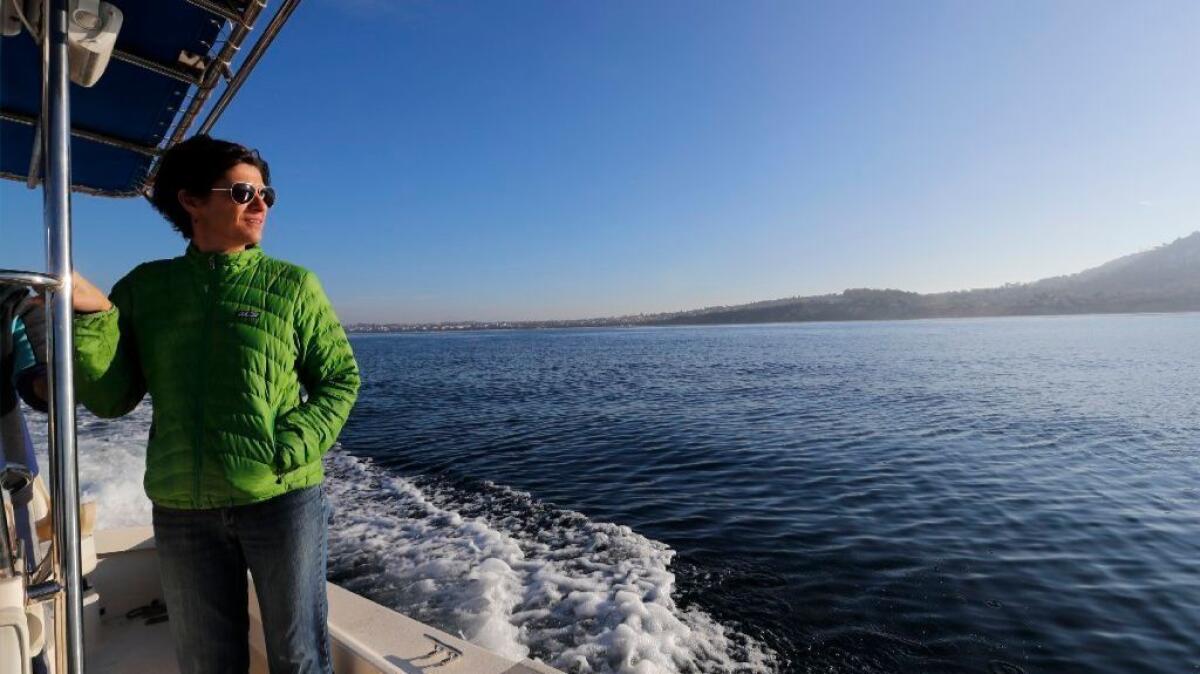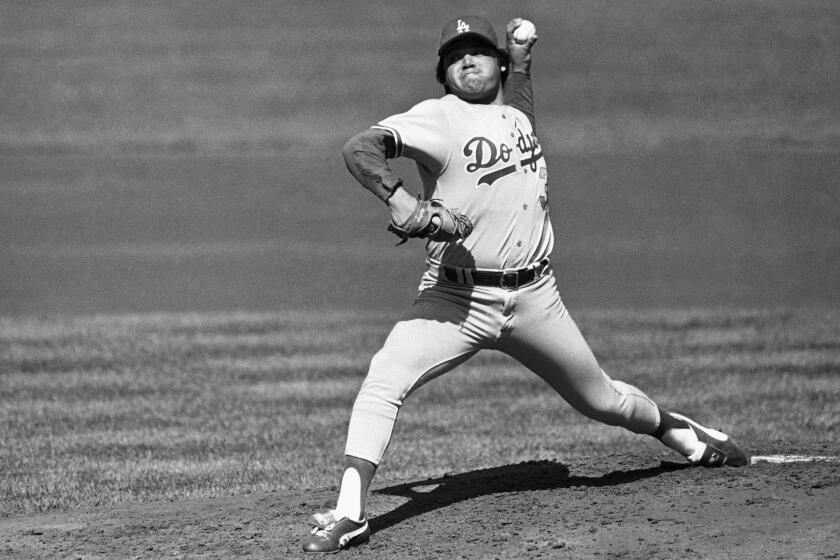Column: Protecting California’s beaches from Donald Trump

The boat left Redondo Beach’s King Harbor early Friday morning under conditions so perfect, I couldn’t think of one good reason to ever go back to the office.
The overnight fog had lifted, with only a thin layer lingering over the Palos Verdes Peninsula. A small swell rolled gently under the boat, gulls sailed through the salt air, harbor seals frolicked and common dolphins used our wake as a playground.
We were headed to Redondo Canyon, just off the peninsula, the day after the Trump administration announced plans to open coastal waters around the country to drilling, including six regions off California. The administration is also rolling back protections put in place to reduce the risk of oil spills.
“This is one of two major submarine canyons in Santa Monica Bay,” Sarah Sikich, vice president of Heal the Bay, said when we arrived at our destination.
Beneath us, in the blue-green depths, fish big and small swam through copper-colored ribbons of kelp.
“Here’s where it drops from shallow to very, very deep,” said Sikich, who wore a hat that said, “Oil & Water Do Not Mix.” “The unique thing is that the canyon supports a diversity of wildlife. One of the things a submarine canyon does for the ecosystem is that it’s a funnel for deep, cold, nutrient-rich waters to come to the surface.”
That makes Redondo Canyon rich in plankton, which draws blue and gray whales, among other wildlife.

Heal the Bay Chief Executive Shelley Luce, left, and Vice President Sarah Sikich are rallying forces against a Trump administration proposal for offshore drilling in coastal waters across the U.S., including six regions off California.
But while some might view the wonder of the sea as a gift too precious to squander, and the green energy movement gains momentum as evidence of climate change becomes undeniable to all but a fossilized few, President Trump sees a different kind of treasure in the depths.
Don’t worry, say the president’s men. Drilling will be good for the economy and energy independence, and the technology is safe.
You can mark Shelley Luce, president of Heal the Bay, as a skeptic.
“We haven’t seen it done safely yet,” said Luce, who joined us on our morning cruise. “There were rules before Deepwater Horizon blew [in 2010 in the Gulf Coast, killing 11, releasing millions of barrels of oil and devastating the environment], and that didn’t help. How many months did it take to cap that? And now the new rules put in place after Deepwater Horizon are being rolled back.”
Some drilling operations are ongoing in California, but there have been no new leases since the Reagan administration. It may be that the drilling plan announced by the Interior Department is all bluster, or that world oil markets will make it impractical to invest in massive new drilling operations. But Californians made clear they are not about to let Trump mess with our beaches or kick sand in our faces.
Gov. Jerry Brown joined the governors of Oregon and Washington — also targeted for coastal drilling — in vowing to resist any attempts to pump black gold from beneath the sea.
Lt. Gov. Gavin Newsom, a member of the state Lands Commission, tweeted “Aint. Gonna. Happen.”
State Sen. Hannah-Beth Jackson (D-Santa Barbara) and Assemblyman Al Muratsuchi of (D-Torrance) reintroduced legislation outlawing new pipelines and other oil-extraction infrastructure in state waters.
“This is our lifeblood, our power and our strength,” Katie Davis said of the California coast and the tourism and fishing industries it supports. The chairwoman of the Santa Barbara Sierra Club recalled the extensive marine damage in 2015 from the Refugio pipeline break and promised to fight any new oil operations.
“We’re fortunate in that we have good congressional leaders, state leaders, business leaders and a very active citizenry broadly united against this,” said Jennifer Savage of Surfrider Foundation. “The latest polling shows that 73% of the people are against offshore drilling.”
Richard Charter, a senior fellow at the Ocean Foundation and a longtime oracle on the dangers of offshore oil and gas extraction, surprised me with his response to the Trump plan. He said he was somewhat relieved.
How so?
Because, in his opinion, the oil and gas grab is so gargantuan, it could collapse under the weight of its own greed.
“I would not have advised them to take every square inch of everything, because politically and strategically, it’s a moronic move,” said Charter, especially coming just after news that the administration wants to relax protections against accidental catastrophes.
“By itself, California might not have been able to stop it,” Charter said of the Trump proposal.
But now we’ve got plenty of allies, because Trump and Interior Secretary Ryan Zinke want to lift bans not just in Alaska and the West, but in the Arctic and along the Eastern Seaboard, where Democratic and Republican governors alike have opposed drilling that could threaten tourism and fishing economies.
In California, the plan would open the northern, central and southern regions to a total of six new drilling sites. Charter said a number of Republican congressional representatives in California “hold seats where they can’t get reelected unless they’re in favor of saving the coast.”
Charter said the oil companies covet oil off La Jolla, Palos Verdes and Malibu, among other places, while the far northern part of coastal California contains natural gas deposits.
“There is no way to assuredly prevent human error or mechanical failure” in extraction, Charter said. “You can’t, and so once you have either routine pollution from day-to-day permitted releases from a rig, or an accidental spill or pipeline spill, you are not going to have the capability to clean it up. You can’t sell that theory in California because we know better, not just from the 1969 blowout in Santa Barbara, but because of Refugio.
“All you have to do is get oil into the prevailing ocean currents and into the food source for our marine ecosystem, and your fishery is toast, and your coastal-dependent tourism is toast.”
And yet, as we saw in its unsuccessful attempt to drill in Hermosa Beach, the oil industry can be expected to spend millions on lobbying and marketing, trying to sell the notion that drilling is safe and that communities will benefit from jobs and tax revenues. And in the near future, for better or for worse, it will have the White House on its side.
On our Friday cruise, the skipper was Apryl DeLancey, interim operations manager at Heal the Bay’s aquarium on the Santa Monica Pier. She said she grew up surfing, kayaking, swimming and diving, and the water quality has vastly improved to the benefit of humans and sea life.
That took decades of work, including public policy changes, public education and a growing respect for our greatest natural resource.
“We used to dump raw sewage into Santa Monica Bay 35 years ago,” said Luce.
The sewage flows out of Washington, D.C., these days, but California is ready for the fight.
“We are not going to go backwards,” said Luce.
Get more of Steve Lopez’s work and follow him on Twitter @LATstevelopez
More to Read
Sign up for Essential California
The most important California stories and recommendations in your inbox every morning.
You may occasionally receive promotional content from the Los Angeles Times.











